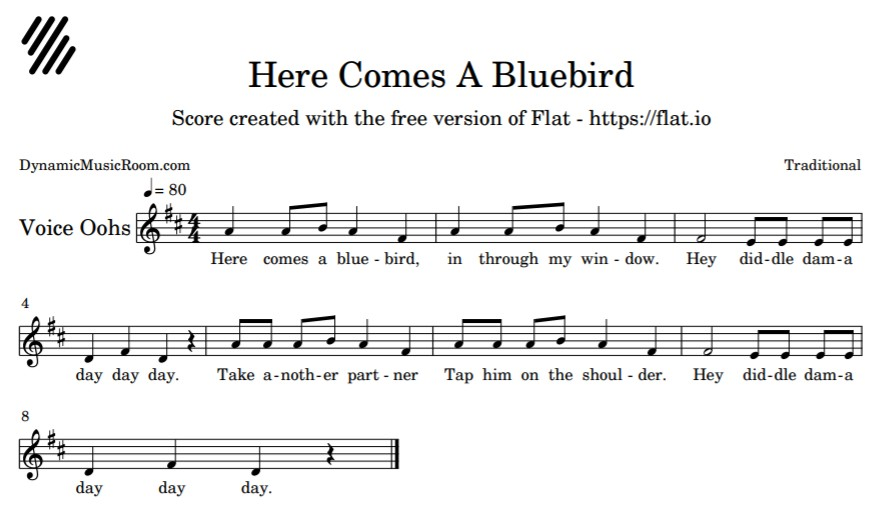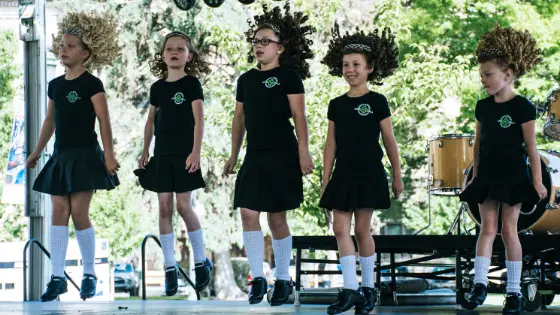Do you love folk dancing but struggle to find easy ways to incorporate it into Kindergarten music?
When I first got into folk dancing with my students, I used it with all of my grades. But I noticed the younger they were, the more the resources I had were beyond their ability.
With my youngest grades, it seemed impossible. So I did some research and found a few folk dances for Kindergarten.
Folk dances for Kindergarten are tricky to find and use. Young students need to be carefully sequenced into them while still being under control and feeling successful.
Look ahead for my 4 favorite folk dances to use with the youngest kiddos.

Save time with these 60 FREE Music Resources to use in your room right away!
Stop searching the whole internet to find good activities. I’ll help you cut to the chase with my favorite 60 FREE resources.
Table of Contents
Should You Teach Folk Dances In Kindergarten?
You may not wish to do folk dancing in the traditional sense with your Kindergarten students. Often, they struggle with keeping a beat as it is, so adding multiple movements to be the beat may be too much.
This is an argument many music teachers and experts make, and it makes a lot of sense.
But personally, I prefer to take a broader view.
Sure, you may not be able to do a lot of the traditional, structured folk dance with these kids, but you are able to prepare with other movement activities. (Check out the best children’s movement books.)
When I hear music teachers say, “Forget folk dance in the younger grades; it’s just not worth it,” I wonder if they’ve given up on movement or if they don’t realize other movement games can still qualify and prepare their kids in the long run.
What To Look For In Folk Dances For Kindergarten
Taking this broader view, you need to look for elements of traditional folk dancing but in a much simpler form. Kindergarten kiddos can do a lot, but give them too much, and they’ll shut down or get goofy.
Here are some elements I look for in a movement activity or folk dance to include it with my Kindergarten curriculum.
Clear steady beat – Most folk dance music has a strong steady beat, but when doing things with Kindergarten you want the beat to be undeniable. The clearer, the better.
Two or three moves – Look for something with very few moves, two or three would be just fine. Any more and it gets too tricky.
Simple moves – For ease of teaching (and safety), look for moves which don’t go far beyond simple clapping, walking, jumping, etc.
No partners or no switching partners – If you have to have partners for a dance, make sure they don’t have to switch. This makes your life a lot easier.
Song included – Folk dances with songs (also known as play parties) work very well with Kindergarten. You have control of the tempo if things get messed up (which never happens with Kinders).
Also, the words in the songs will often help your kids remember what moves are coming.
You may also enjoy 4 easy folk dances to teach.
Breakdown Of 3 Simple Folk Dances
In this section, I’ll go through my teaching process and game directions for these folk dances. Source links are included where possible.
You may also want to check out these best freeze dance songs and how to play guide.
Here Comes A Bluebird
There are many versions of this song, but my favorite is the one notated below. This one may not seem like a true folk dance, but it’s not supposed to be.
This game reinforces movement to the beat, repetition, and moving together in groups.
Game Directions:
- All students except one in a circle holding hands with their arms up.
- The one student flaps their arms like wings to the beat while going in and out of the circle for the 16 beats.
- On the words, “tap them on the shoulder,” the student taps the nearest other student on the shoulder.
- The chosen student joins the original one in a line with the new student at the front. The behind student places his or her hands on the leader’s shoulders.
- Two students close the gap made by the chosen student.
- Repeat the steps with a line of 2 students. Only the new student in front picks someone at the end.
- The 3rd student joins the front of the line and the other two place their hands on the shoulders of the person in front of them.
- Close the gap of the newly chosen student.
- Repeat until all students are part of the line.

Royal Reel
This is a simple folk dance I created to give a basic introduction to moving to reels and traditional folk dance music.
This “folk dance” won’t win any awards, but the ideas behind it are present in most folk dances.
I believe it provides a needed bridge between movement games (like the others on this list) and more traditional folk dances.
Game Directions:
- Students are in a line following the teacher.
- March around in follow-the-leader fashion behind the teacher for 16 counts.
- Walk on tip toes in follow-the-leader fashion behind the teacher while clapping hands to the beat for 16 counts. (Teacher ends this phrase with the class back in a circle)
- Students and teacher face inside the circle. Students follow the teacher’s beat motions (i.e. clapping, patting, etc) for 16 beats.
- Teacher passes the “royal scepter” (fancy mallet, stick, or boomwhacker) to a student, and they are the ruler and give 16 counts of beat movements.
- Class turns to their right (or left, it doesn’t matter as long as they all move the same way!) and follows the new leader as you repeat the moves from the beginning.
Note: You may need to step in to help the leader get the class back into a circle before it’s time to do the move. But the beauty of such a simple dance is that if you miss the phrase’s end, just wait for the next one.
I like this reel performed by Sean Softley for background music. It has a great beat anyone can follow.
Did You Ever See A Lassie?
This song and game has its roots in a German song, “Buy A Broom,” but was published in American in the book Folk Songs Of New England in 1939.
This is a fun song in a fast 3/4 which is rare. The directions are simple and the melody is catchy.
Game Directions:
- Students in a circle, students skip or gallop the first 8 measures to the right.
- For the next 8 measures, one student (at your choice) goes in the middle and does a move while the other students follow him or her.
- Repeat from the beginning choosing a different student to lead the moves every time.
Note: If a boy is chosen, feel free to change the words to “laddie” instead of “lassie.”
Source: American Folk Song Collection
Ring Around The Rosie
OK, pretty much everyone knows this traditional circle game. But when it comes to the introduction of structured movement, it doesn’t get more basic yet classic than this.
You may not want to teach this song because it’s too classic. Surely, everyone already knows it.
But the harsh reality is quite different. Many parents don’t teach their kids these classic songs and play with them anymore.
We can’t fix it all, but we can do our part to help keep our musical traditions alive.
Game Directions:
- Students take hands and circle to the right for the whole song.
- Students drop hands and fall to the ground on the phrase, “we all fall down.”
Notation at Montessori World.
Conclusion
I hope you find these 3 folk dances for Kindergarten helpful and applicable to your classroom.
Folk dance is a great way to connect to the cultural heritage of the dance while reinforcing musical concepts like form and beat.

Save time with these 60 FREE Music Resources to use in your room right away!
Stop searching the whole internet to find good activities. I’ll help you cut to the chase with my favorite 60 FREE resources.



